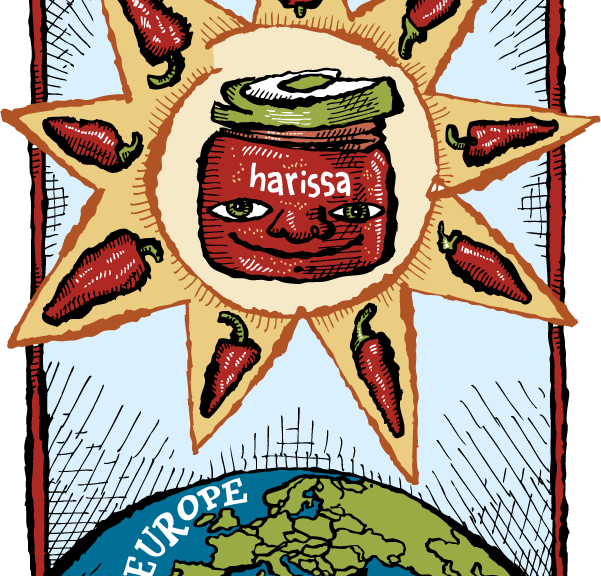I’ve never been to Tunisia, but I bet you don’t find too many hot dog carts on the streets. If you did though, on the condiment rack, instead of our ubiquitous squeeze bottles of ketchup you’d find jars of harissa.
Harissa is a spread made of dried peppers crushed with tomato, garlic, olive oil, caraway and coriander. It’s eaten across North Africa, where it’s made slightly differently by each cook. It’s eaten with all sorts of dishes, from couscous to omelets, from soups to meats. Majid Mahjoub, the man who makes the fantastic harissa we’ve stocked our shelves with for the past few years, describes it as the element that helps the cuisine of the poor peoples of North Africa come to life.
Think of harissa as sriracha’s cool North African cousin.
Sriracha is the current darling of the hot sauce world—it’s that squeeze bottle with the rooster you see all over the place. With its tangy sweet kick, it’s woven its way into the fabric of hipster eateries across the country where it’s used to add a zip to everything from its native Thai food to pizzas and tacos.
Despite their origins on opposite sides of the world, sriracha and harissa are more similar than you’d think. Both sauces have enough spice to add a bold kick to a dish without overwhelming the flavor. While sriracha gives a bright burst of heat with a clean sweetness, harissa is deeper. It’s rich with the flavor of roasted pepper and sun dried tomato and has a slow-building, mouth-filling heat. The flavor lingers long after you finish eating it. Harissa is also thicker. Its consistency is closer to a coarse tomato paste than ketchup, so you spoon it out of a jar instead of squeezing it out of a bottle.
The function is similar, but how the sauces are made is different.
The past several months, the makers of the classic rooster bottle brand of sriracha have been embroiled in legal battles. The California town where the sauce is made has filed injunctions against the company for being a public nuisance by fouling up the air with the fumes that come from processing the peppers and garlic used to make the sauce. While we wait for the conclusion of the lawsuit, we can only speculate about the future supply of sriracha.
As for harissa—I don’t think we need to worry about air quality legal troubles any time soon. To make their harissa, the Mahjoubs start with three varieties of peppers—two sweet, one hot— all of which are grown organically on their farm. The peppers are dried in the sun for about a week, during which time a hundred pounds of fresh peppers reduces down to just five pounds of dried peppers with intensely concentrated flavor. (Note that they get more flavorful—not spicier. The seeds are the source of most of the spice and they’re mostly removed to make harissa.) The dried peppers are mixed with the family’s sun dried garlic and tomatoes, caraway, coriander, and their own extra virgin olive oil. The result is a seriously flavorful condiment. It could be used either to add intensity to a dish while you’re cooking it, or to add a kick to a finished dish. Like these:
Here are seven ways to use harissa this weekend.
1. Toss over pan-fried potatoes
2. Spread on grilled sausages or a hamburger
3. Whip into cream cheese to spice up your bagel
4. Swirl into tomato sauce to kick up pasta , couscous, or pizza
5. Drizzle over scrambled eggs
6. Whisk into a vinaigrette with good oil and vinegar for a punchy salad
7. Slather onto a killer grilled cheese sandwich
Or you could make the best tuna sandwich ever.
Sandwich Tunisienne
4-6 hearty slices good bread
1-2 tablespoons good extra virgin olive oil
1-2 spoonfuls of harissa
1 tin good tuna
1 preserved lemon, sliced thin
1. Take the bread and brush the sides that will be insides of your sandwiches with enough olive oil that it soaks into the bread a bit
2. On top of the olive oil, spread a generous spoonful of harissa on the bread—taste it first, and then use more or less depending on how hot you want the sandwich to be
3. On the bottom slices of bread, add the tuna (I like about a third of a tin per sandwich) and enough slices of preserved lemon to get some in every bite
4. If you want to add in any additional ingredients, like capers, artichokes, or roasted red peppers, pile ‘em on
5. Put the top slice of bread on, and squish the sandwich together
The sandwiches are good right away, and even better after sitting for a bit when the oil soaks into the bread and the flavors really meld together.
Makes 2-3 hefty, messy sandwiches

